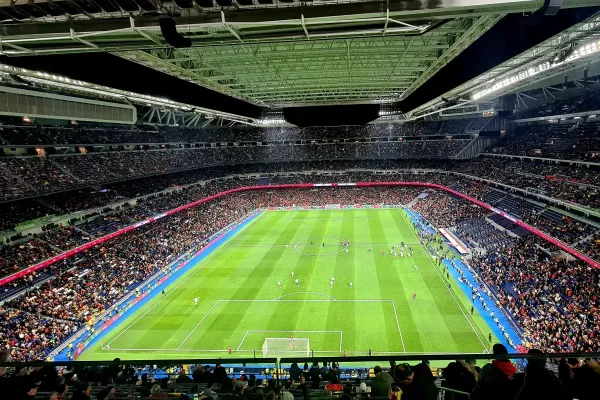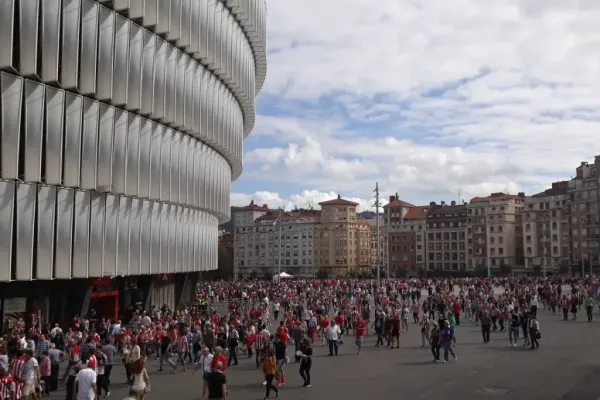
With the World Cup coming to the country in 2030, renovation work will take place at many of the most important Spanish football stadiums over the coming years. Even today, there are already a number of great venues that boast large capacities, modern facilities and are capable of serving up special atmospheres.
Here’s a rundown of the biggest stadiums in Spain, based on their current capacities or future capacity in the case of FC Barcelona where Camp Nou renovation work is actively ongoing.
Spain does not have a national stadium as such, but Seville’s Cartuja is the closest thing to it currently, as the largest venue in the country that is not a club ground.
It was initially built during Spain’s construction boom, as the venue for the 1999 Athletics World Championships. While it sporadically hosted major events, such as the 2003 UEFA Cup final (pictured below) between Porto and Celtic in the following years, Cartuja largely came to be one of Spain’s least loved football stadiums, with an ugly exterior, athletics track and inaccessible location.
In fact, the entire project was seen as something of a “white elephant” given its limited use, with the city already home to two excellent and much more atmospheric football grounds.
In recent years, the Spanish football federation has attempted to revive Cartuja and at least make it more relevant. Since 2020, it has become the annual venue for the Copa del Rey final, and it also stepped in to host matches at the delayed Euro 2020.

The biggest football ground in Seville and fourth largest of all the LaLiga stadiums, the Benito Villamarin has been home to Real Betis for nearly a century, although it has undergone several major facelifts and name changes over the years.
The most recent development saw the demolition and subsequent expansion of the South Stand, home of the notorious “Supporters Sur” ultras in the 2010’s. Completed in time for the 2017/18 season, the Benito Villamarin now has a capacity of over 60,000.
Since the pandemic, Betis have always ranked in the top four when it comes to LaLiga attendances, with their large and loyal fanbase currently ensuring average crowds at the Benito Villamarin stand at around 50,000.

Atletico Madrid made the move to the Estadio Metropolitano in 2017, leaving behind their iconic former home in the heart of the Spanish capital, to move some 12 km to the east and a new site on the edge of the city.
Abandoning the now demolished Vicente Calderon, on the banks of Rio Manzanares, was not an easy decision, but Atleti fans have continued to travel in vast numbers to the new stadium and the club has been able to generate much greater revenues as a result.
The stadium is regularly packed out for Madrid derbies and big Champions League nights, and now boasts a capacity of more than 70,000, following recent seating expansion. While some Atleti supporters still miss the old Calderon, the club is largely viewed as having done a good job of retaining the atmosphere at their new home.

While they have not moved home, there has been significant redevelopment work across town at the Santiago Bernabeu in recent years.
While there have not been significant changes in terms of the overall structure or capacity of the stadium inside, the exterior has been completely redone, while a retractable roof has been added, as has a spectacular 360 degree video scoreboard. The work has given the Bernabeu the feel of a modern NFL stadium, and it will indeed host NFL matches and other major sporting events and concerts over the coming years.
Its primary purpose will of course remain being the venue for Real Madrid home matches. Despite the difficulty of getting tickets to see Los Blancos in action, official attendances have not topped 80,000 for even the biggest matches since renovation was completed.
That has led to doubts as to the actual capacity. Some sources cite a capacity of 85,500, but club president Florentino Perez claimed “At the Bernabeu we have permission for 80,000 spectators – plus or minus 1,000” at the club’s annual meeting in 2023.

The largest stadium in Spain, and biggest in Europe, will be Camp Nou when the extensive redevelopment work is finally completed. Barcelona will move back into their iconic home at some point in 2025, initially at a reduced capacity while construction work continues.
When complete, the new Camp Nou will hold 105,000 spectators, more than 10,000 more than Wembley in London which is currently the continent’s largest. That’s a slight increase on the capacity of the old ground which was just shy of 100,000.
While the project is expected to cost well over €1m, Barcelona hope they will ultimately have the best stadium in the world. The club has huge debts, but should start generating huge revenues again once Camp Nou is fully operational, expected to be by the beginning of the 2026/27 season, although there have already been significant delays.
| Stadium | City | Club | Capacity | |
| 1. | Camp Nou | Barcelona | Barcelona* | 105,000* |
| 2. | Santiago Bernabeu | Madrid | Real Madrid | 81,000 |
| 3. | Metropolitan Stadium | Madrid | Atletico Madrid | 70,560 |
| 4. | Benito Villamarin | Seville | Real Betis | 60,721 |
| 5. | The Cartuja | Seville | – | 57,619 |
| 6. | San Mames | Bilbao | Athletic Club | 53,289 |
| 7. | Lluis Companys Olympic Stadium | Barcelona | Barcelona* | 49,472 |
| 8. | Mestalla | Valencia | Valencia | 49,419 |
| 9. | Ramon Sanchez Pizjuan | Seville | Sevilla | 43,883 |
| 10. | Real arena | San Sebastian (Donostia) | Real Sociedad | 40,000 |
*Barcelona are playing at the Estadi Olimpic Lluis Companys, which has its capacity capped at just under 50,000 for football matches, while Camp Nou renovation work continues.
There are a number of other football stadiums in Spain with a capacity of over 40,000. The biggest of those is San Mames in Bilbao, which replaced the old San Mames which was situated on the same site as the home of Athletic Club during the 2013/14 season.
The old ground was known as ‘La catedral’ and it played a vital role in the growth of football in the early days in Spain. The new stadium is a modern arena with a stunning exterior and it still offers arguably the best atmosphere in LaLiga, while the decibel levels also soar on big cup nights.

Mestalla is another of Spain’s legendary football grounds. Despite work on a Nou Mestalla commencing way back in 2007, the project has been hit by numerous delays and interruptions, and it remains unclear whether Valencia will ultimately make the move away from their current home with its brilliantly steep stands that leave fans virtually on top of the pitch.
Sevilla are also planning major redevelopment work at the Ramon Sanchez Pizjuan, another of the country’s loudest stadiums. Real Sociedad’s Reale Arena also just hits 40,000 and is a much-improved venue after significant work in recent years to reduce the gap between the stands and the pitch.
By 2030, there could be a number of other expanded or new Spanish football stadiums in time for the World Cup. Grounds in A Coruña, Zaragoza, Malaga and Las Palmas could all join the list of stadiums in Spain with capacities of over 40,000 by that point.